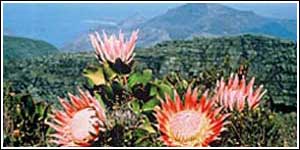Cape Floral Region
Year inscribed: 2004
Location: Western and Eastern Cape, 34 10′ S 18 22′ 30″ E
Type: Natural heritage
The Cape Floral Region takes up only 0.04% of the world’s land area, yet contains an astonishing 3% percent of its plant species. This makes it one of the richest areas for plants in the world and one of the globe’s 18 biodiversity hot spots.
A stretch of land and sea spanning 90 000 square kilometres, the 553 000-hectare Cape Floral Region comprises eight protected areas stretching from the Cape Peninsula to the Eastern Cape: Table Mountain, De Hoop Nature Reserve, the Boland mountain complex, the Groot Winterhoek wilderness area, the Swartberg mountains, the Boosmansbos wilderness area, the Cederberg wilderness area, and Baviaanskloof.
Kirstenbosch Botanical Garden on the slopes of Table Mountain is part of the region, making it the first botanical garden ever included in a World Heritage site.
The rich diversity of the Cape Floral Region contributes to South Africa having the third-highest level of biodiversity in the world. Table Mountain National Park, for example, has more plant species in its 22 000 hectares than the British Isles or New Zealand.
The Cape Floral Region is not only remarkable for its diversity. The region’s endemism level, at 31.9%, is the highest on the planet. Of the 9 600 species of vascular plants (plants with vessels for bearing sap) found here, some 70% are endemic, occurring nowhere else on earth.
The region is home to nearly 20% of Africa’s flora, though it makes up less than 0.5% percent of the continent’s land mass.
It is also home to 11 000 marine animal species, 3 500 of which are endemic, and 560 vertebrate species, including 142 reptile species, of which 27 are endemic.
In granting the Cape Floral Region World Heritage status in 2004, the World Heritage Committee noted: “Unique plant reproductive strategies, adaptive to fire, patterns of seed dispersal by insects, as well as patterns of endemism and adaptive radiation found in the flora are of outstanding value to science.”

